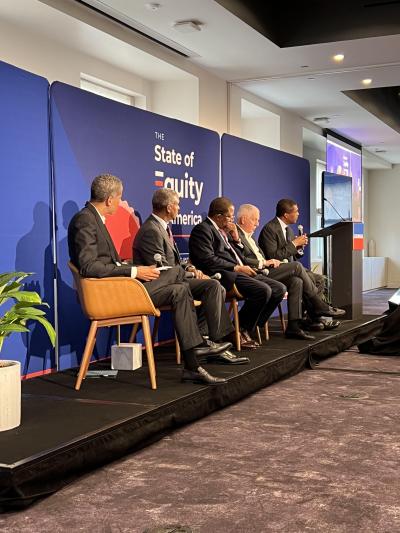NEW YORK—Recent data from the Harris Poll show nearly half of BIPOC Americans have received low-quality care in the last year and have sought a second opinion because they felt their initial concerns were dismissed.
These patients are more likely to make trade-offs related to the cost of healthcare, and their mental health is burdened by socioeconomic stressors, according to the data, which were presented at the inaugural U.S. News & World Report State of Equity forum last week in New York City.
“We haven’t done the hard work,” said Pamela Sutton-Wallace, Yale New Haven Health's chief operating officer, in response to the findings. “It really is about how do we move from the conversation—move from the data collection—to actual implementation of solutions that we know can change, fundamentally, some of those really important statistics," she said during the forum.

Healthcare executives weighed in on disparities and ways to address them at the forum. (Anastassia Gliadkovskaya)
Per the Harris Poll data, Black and Hispanic patients report they want their providers to be genuinely interested in their concerns and well-being and to explain things in an understandable way. The fact that the patient experience of people of color is just as problematic as their clinical outcomes highlights the importance of collecting data on processes beyond the clinical setting to identify disparities, Sutton-Wallace said. “Are the things that we are doing—again, structurally—creating the inequities?” she posited. “We know it is creating the inequities.”
With patients, trust is key in order to collect race, ethnicity and even genomics data to study disparities, healthcare executives said.
“We haven’t done that well,” Selwyn Vickers, M.D., CEO of Memorial Sloan Kettering Cancer Center, said. “Getting rid of disparities is good for America, not just for people of color.”
When NewYork-Presbyterian tried to collect this data, 40% of its patients did not want to share the information, echoed Steven Corwin, M.D., the health system’s CEO. The organization developed "We Ask Because We Care," an educational campaign that aims to explain to patients why the health system is requesting the data.
Health system executives and physician leaders agreed that eradicating disparities must start with representation at the employee level. Corwin cautioned against being over-reliant on a younger generation of incoming providers to stack diversity throughout healthcare. “Who are they looking to be their mentors?” he asked, noting it’s critical to have underrepresented minorities of all ages and at all levels of an organization.
“We need to be diverse in the specialties,” echoed Wayne Riley, M.D., president of SUNY Downstate Health Sciences University. “That’s a remaining frontier that we have to tackle.”
When it comes to paying for healthcare, Sutton-Wallace highlighted recent Kaufman Hall estimates that more than half of U.S. hospitals are expected to have negative margins through the end of the year. Yale New Haven Health itself took a $300 million loss this year alone, she noted.
Beyond the pandemic, other executives spoke about the fundamentally broken system of reimbursement.
A third of NewYork-Presbyterian’s patients are commercially insured, Corwin noted. The other two-thirds are on Medicare and Medicaid. Because public programs reimburse less on the dollar, while commercial pays more than 1:1, the health system can afford to cross-subsidize these populations.
“If you’re in a situation as a safety net hospital where your commercially insured population is 20% or below, you’ve got a problem,” Corwin said.
Indeed, one such hospital is Montefiore Medicine, with a mission to maintain access to care for all. The health system has 15% of patients that are commercially insured, said Philip Ozuah, M.D., the organization’s CEO. They account for nearly half of all of its revenue. Medicaid and Medicare rates have had little increases in payment rates over a decade, Ozuah noted, while prices have continued to rise, making it increasingly difficult to subsidize those patients.
“The mission goes out of existence if we don't have those commercial rates,” Ozuah said.
Memorial Sloan Kettering Cancer Center, meanwhile, does not have a lot of Medicaid patients. So the organization fought for a bill, passed this year, that would require Medicaid-managed care plans to contract with NCI-designated cancer centers like Memorial Sloan. With the law taking effect in January 2023, the organization plans to grow that segment of its payer mix, Vickers said.
Sutton-Wallace believes moving to value-based care and payment models is an important way to help pay for care. It is also important to equalize the number of patients various hospitals are treating and to be realistic about what institutions are paying for. “There’s enough money in the system, it’s just not being placed in the right places,” she contended. Corwin agreed, saying the federal government should bear more financial responsibility for public programs as states continue to expand the Affordable Care Act.
Several executives called for the expansion of Medicaid to help broaden access to care. But regulating the amount to which healthcare costs can grow is a key component to that equation, Vickers noted: “Even if you expand Medicaid, it’ll never keep up with the cost of where our healthcare is going.”